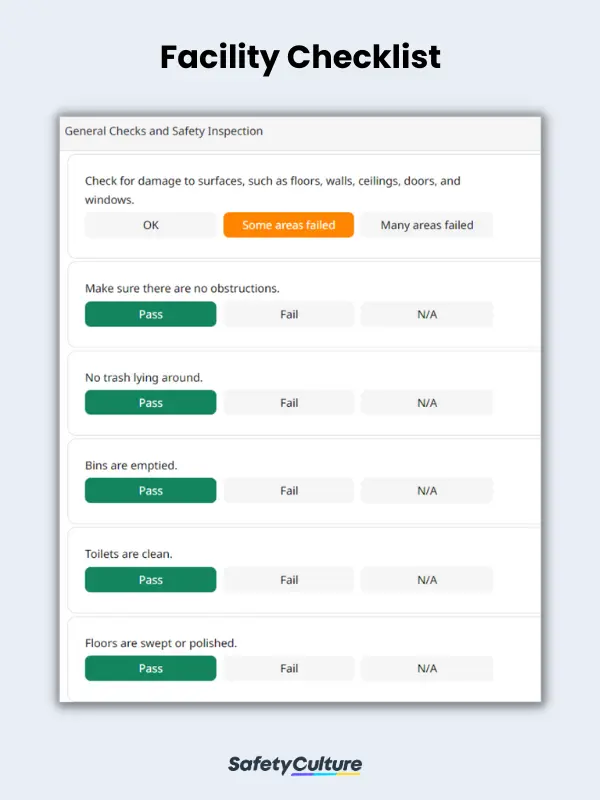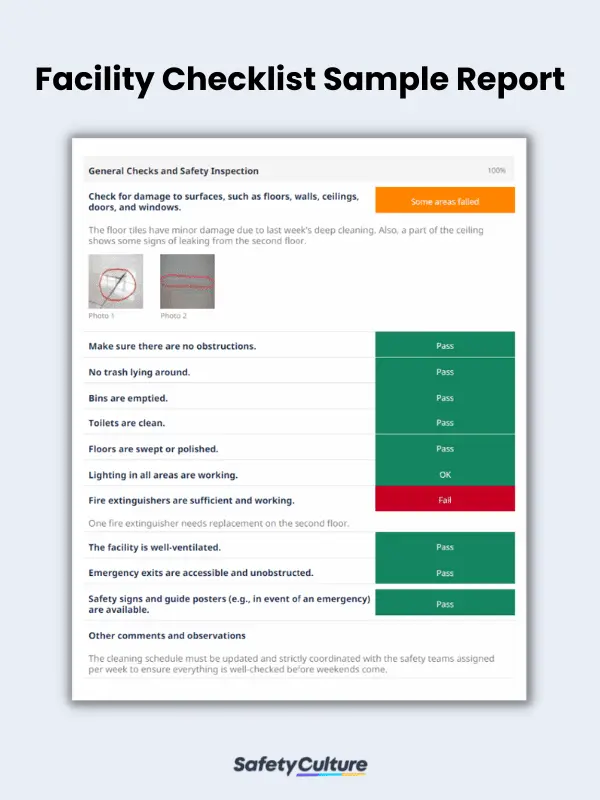What is a Facility Checklist?
A facility checklist is a tool and a comprehensive guide that helps facility managers and staff ensure the safety and security of the building and its occupants. The checklist should include all areas of the building, from the parking lot to the roof, and should be updated regularly to ensure that it reflects the current condition of the facility.
Why Use a Facility Checklist
Facility checklists are an important part of good facility management. They help ensure that all aspects of the facility are being properly managed, all required safety equipment is properly installed and functioning, and that no important maintenance, inspection, and cleaning operations are being overlooked.
Another purpose of a facility checklist is to help inspectors, safety officers, and facility coordinators identify potential safety and security hazards and take steps to mitigate them. It also serves as a standard, comprehensive guide in reviewing the condition of the grounds, parking lot, and any other areas that may impact the safety and security of the facility.
Further, this kind of checklist creates a system for managing important tasks, ensuring that all tasks are completed, and improving communication across the people and teams involved in facility management. This helps provide documentation of the work that has been done, which can be crucial when dealing with insurance claims, improving facility management processes, or addressing facility safety issues.
Types
There are many different types of facility checklists, and they may vary depending on the type of facility. Regardless of type, they should be updated regularly to ensure that they are accurate and up-to-date.
In general, facility checklists can be divided into two categories:
- Safety checklists should be completed before or during each shift to ensure that all safety features and procedures are in place and functioning as intended. Some common items that are checked on safety checklists include fire exits, fire extinguishers, first-aid kits, and evacuation routes. It’s important to tailor safety checklists to the specific facility. For example, a hospital safety checklist will differ from a factory safety checklist, even if they’re both considered facilities.
- Daily checklists should be completed at the beginning of each shift to ensure that all areas of the facility are inspected and that safety protocols are being followed. The most basic items that are inspected on daily checklists include floors, walls, ceilings, and windows.
What to Include in a Facility Checklist
A facility checklist, in general, must include the following elements and supplementary sections to make it comprehensive:
Title page
Start your facility checklist with a title page that includes the following details:
- Facility location
- Inspection date
- Inspector name
Review of the facility’s physical condition
The checklist must also let you inspect the condition of the facility’s physical environment. This may cover surface damage to floors, walls, ceilings, doors, and windows. Also, lighting, ventilation, and cleanliness are checked.
Review of the facility’s security, maintenance, and safety procedures
In this part of the checklist, verify if emergency exits are accessible and unobstructed, check the availability and efficiency of fire extinguishers and alarm systems, and make sure that there’s enough food and water to last for several days in the event of an emergency.
Further, you can check whether specific instructions for handling a variety of potential crises, such as a fire or a power outage, are available.
Completion page
Allot the final page of your checklist to summarize the needed actions, list recommendations or next steps, and sign off the inspection.
Here’s a visual example of a completed facility checklist report.
How to Use
Now that you’re familiar with the general steps on how you must create a facility checklist, here are the best practices on how to use it in your facility management activities:
As a safety tool
A facility checklist is an effective way to improve safety by ensuring that all safety features of a facility are operational. Before beginning any work in the facility, each worker should consult the checklist to be sure they are aware of all potential hazards in the area. The checklist can also help identify any potential safety hazards, create a plan for safe work practices, and prevent accidents from occurring.
As a quality management tool
Facility checklists can help managers and staff ensure that all areas of a facility are functioning properly and helps the organization meet its quality standards. Following a regularly scheduled inspection or maintenance task, workers must check equipment, machinery, tools, and facility amenities to ensure they are in good working order and continues to help deliver quality products and services.
Some other tips for using facility checklists include the following:
- Have a designated individual or team responsible for checking each area of the facility, and creating a checklist that is specific to that area.
- Train all staff on how to use the checklists, and what to do if they encounter a problem.
- Assess and update checklists regularly to ensure they’re aligned with the organization’s needs and that all tasks are being completed.
- Review the checklist after the specific facility management task to identify potential problems, recommend solutions, and implement action plans.
FAQs About Facility Checklists
Facility checklists are important tools that should be used by everyone involved in the management, operation, and upkeep maintenance of a facility—from the property manager and the head of housekeeping to safety supervisors and building inspectors. Those in management and supervisory roles can initiate, standardize, or approve the process of creating such checklists.
The checklist can be used for both periodic and on-demand reviews of the facility. For periodic use, it can be utilized to ensure that all aspects of the building’s infrastructure are accounted for and functioning properly.
An Occupational Safety and Health Administration (OSHA) facility inspection checklist helps organizations maintain compliance with the OSH Act of 1970 with the aim of preventing workers from being seriously harmed at work. This tool is used primarily by safety officers, supervisors, and OSHA inspectors.




